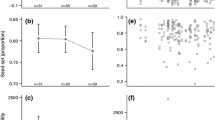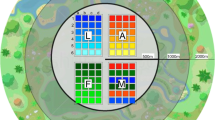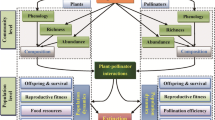Abstract
Destruction and fragmentation of natural habitats is the major reason for the decreasing biodiversity in the agricultural landscape. Loss of populations may negatively affect biotic interactions and ecosystem stability. Here we tested the hypothesis that habitat fragmentation affects bee populations and thereby disrupts plant-pollinator interactions. We experimentally established small ”habitat islands” of two self-incompatible, annual crucifers on eight calcareous grasslands and in the intensively managed agricultural landscape at increasing distances (up to 1000 m) from these species-rich grasslands to measure effects of isolation on both pollinator guilds and seed set, independently from patch size and density, resource availability and genetic erosion of plant populations. Each habitat island consisted of four pots each with one plant of mustard (Sinapis arvensis) and radish (Raphanus sativus). Increasing isolation of the small habitat islands resulted in both decreased abundance and species richness of flower-visiting bees (Hymenoptera: Apoidea). Mean body size of flower-visiting wild bees was larger on isolated than on nonisolated habitat islands emphasizing the positive correlation of body size and foraging distance. Abundance of flower-visiting honeybees depended on the distance from the nearest apiary. Abundance of other flower visitors such as hover flies did not change with increasing isolation. Number of seeds per fruit and per plant decreased significantly with increasing distance from the nearest grassland for both mustard and radish. Mean seed set per plant was halved at a distance of approximately 1000 m for mustard and at 250 m for radish. In accordance with expectations, seed set per plant was positively correlated with the number of flower-visiting bees. We found no evidence for resource limitation in the case of mustard and only marginal effects for radish. We conclude that habitat connectivity is essential to maintain not only abundant and diverse bee communities, but also plant-pollinator interactions in economically important crops and endangered wild plants.
Similar content being viewed by others
Author information
Authors and Affiliations
Additional information
Received: 7 May 1999 / Accepted: 19 July 1999
Rights and permissions
About this article
Cite this article
Steffan-Dewenter, I., Tscharntke, T. Effects of habitat isolation on pollinator communities and seed set. Oecologia 121, 432–440 (1999). https://doi.org/10.1007/s004420050949
Issue Date:
DOI: https://doi.org/10.1007/s004420050949




